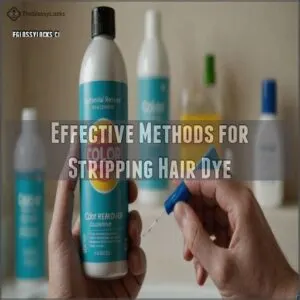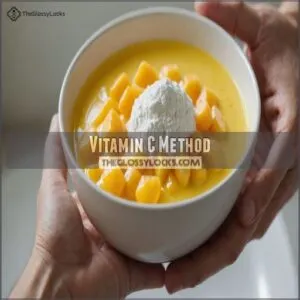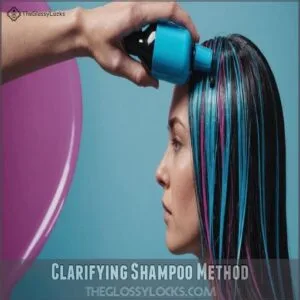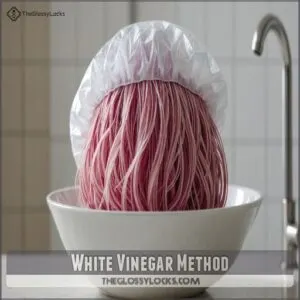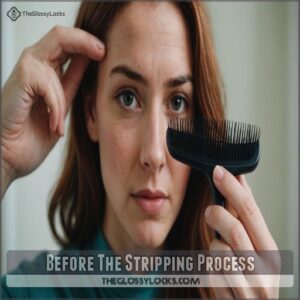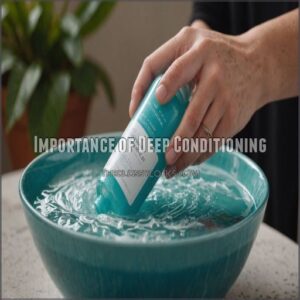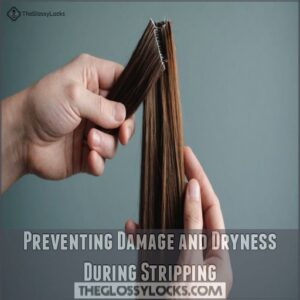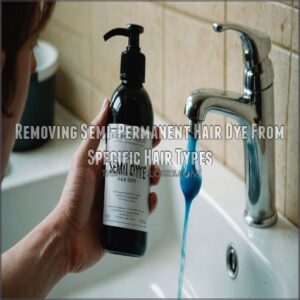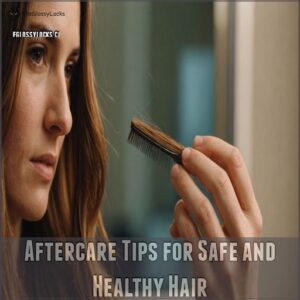This site is supported by our readers. We may earn a commission, at no cost to you, if you purchase through links.

Start with a clarifying shampoo, which acts like a gentle reset button for your hair.
For a stronger approach, mix vitamin C tablets with anti-dandruff shampoo – it’s like a DIY color eraser that actually works.
White vinegar rinses can fade the color gradually, while store-bought color removers pack more punch.
If you’re dealing with stubborn dye, a professional colorist might be your best bet.
Just remember to deep condition your hair throughout the process – there’s a secret to keeping your strands silky smooth while saying goodbye to unwanted color.
Table Of Contents
- Key Takeaways
- Effective Methods for Stripping Hair Dye
- How to Remove Semi Permanent Hair Dye
- DIY Stripping Methods for Semi-Permanent Dye
- Using Color Remover Products for Semi-Permanent Dye
- Preparing Your Hair for Stripping
- At-Home Stripping Methods to Avoid
- Professional Removal Methods for Semi-Permanent Dye
- Preventing Damage and Dryness During Stripping
- Removing Semi-Permanent Hair Dye From Specific Hair Types
- Aftercare Tips for Safe and Healthy Hair
- Frequently Asked Questions (FAQs)
- How to remove semi-permanent hair dye at home?
- How to remove semi-permanent hair color?
- How do I remove dye from my hair?
- Does color remover work on dyed hair?
- How do you wash bleach out of your hair?
- Can baking soda remove hair dye?
- How do you remove semi-permanent hair dye fast?
- How do you make semi-permanent hair dye go away faster?
- Can semi-permanent hair dye come out completely?
- What color remover removes semi-permanent hair dye?
- How long should I wait between color stripping sessions?
- Can chlorine from swimming pools fade semi-permanent dye?
- Will color stripping affect my natural highlights?
- Can semi-permanent dye be stripped during pregnancy?
- Which hair colors are hardest to strip completely?
- Conclusion
Key Takeaways
- You’ll get the best results with clarifying shampoo mixed with crushed vitamin C tablets – apply to damp hair for 30 minutes, then rinse thoroughly and deep condition.
- You can use white vinegar rinses to gradually fade color – mix equal parts vinegar and warm water, leave for 15-20 minutes, and repeat daily for up to three days.
- You’ll want to avoid harsh DIY methods like baking soda or dish soap that can severely damage your hair – stick to gentle commercial color removers or salon treatments instead.
- You’ll need to deep condition your hair throughout the stripping process – use protein-rich masks twice weekly and consider protective styles while your hair recovers.
Effective Methods for Stripping Hair Dye
You’ll find several effective ways to strip that stubborn hair dye, from gentle clarifying shampoos to more powerful color removers that work with your specific hair type.
Semi-permanent dye removal
Whether you’re trying to fix a color mishap or just ready for a change, these proven methods will help you remove semi-permanent dye while keeping your hair healthy and strong.
Choosing The Right Method for Your Hair Type
Picking the right hair stripping method isn’t one-size-fits-all – your hair type makes all the difference.
Before diving in, consider these important factors about your locks:
- Previously bleached hair needs extra TLC and gentle methods
- Fine hair can handle most treatments but requires close monitoring
- Curly hair (3B-4C) demands moisture-rich approaches
- Natural hair textures 1-3A typically respond well to standard methods
Just remember: when in doubt, start with the gentlest option first.
Common Stripping Methods
When it comes to hair dye removal, you’ll find several proven methods that pack a punch.
Bleach remains the heavyweight champion, capable of lifting color up to nine shades.
Clarifying shampoo offers a gentler approach, while DIY methods like vitamin C and white vinegar provide natural alternatives.
Color removers specifically designed for semi-permanent dyes strike a sweet spot between effectiveness and gentleness for most people.
Potential Risks and Damage
Three major risks come with stripping your hair dye, and you’ll want to know them before diving in.
While the promise of a fresh start is tempting, your hair might’ve other plans.
Here’s what you should watch out for:
- Severe dryness and breakage, especially if your hair’s been previously processed
- Scalp irritation and potential chemical burns
- Uneven color results and stubborn patches
How to Remove Semi Permanent Hair Dye
Want to hit the reset button on your hair color? Understanding the properties of semi-permanent hair dye, such as its temporary color change without harsh chemicals like ammonia or peroxide, how to remove semi permanent hair dye. You’re not alone – removing semi-permanent dye is a common challenge that needs the right approach to avoid damage. Before diving into any removal method, it’s essential to understand what you’re working with. If you’re looking for a safe and effective method, consider using a clarifying shampoo technique that removes unwanted color without harsh chemicals.
Here’s what you need to know before starting:
- The age of your dye matters – newer colors (1-2 weeks old) are typically easier to remove than those that have had time to settle into your hair shaft
- Your natural hair texture affects how quickly color fades – fine hair often releases dye more easily than coarse strands
- Previous chemical treatments impact your options – if you’ve bleached before, you’ll need gentler removal methods
Think of hair dye removal like peeling an onion – it’s often a gradual process that requires patience and the right technique for your specific situation.
DIY Stripping Methods for Semi-Permanent Dye
If you’re ready to say goodbye to your current hair color, you’ll be glad to know that common household items like vitamin C tablets and white vinegar can effectively strip away semi-permanent dye.
These wallet-friendly methods work by gently breaking down the color molecules in your hair, giving you a fresh start without the harsh chemicals found in commercial products.
Vitamin C Method
The vitamin C method stands out as one of the gentlest ways to strip unwanted hair color at home.
Simply crush 5-10 vitamin C tablets (or use powdered form), mix with hot water to create a thick paste, and apply thoroughly to damp hair.
Cover with a plastic cap and let it sit for 45 minutes.
You’ll likely need 2-3 treatments over a week to see noticeable results.
Clarifying Shampoo Method
If vitamin C didn’t do the trick, reach for a clarifying shampoo—your hair’s gentle reset button.
Like a deep clean for your locks, this method gradually fades unwanted color without harsh chemicals.
Here’s your game plan:
- Wet your hair thoroughly with warm water
- Apply clarifying shampoo, massaging deeply into roots
- Cover with a shower cap for 5-10 minutes
- Rinse with warm water, then deep condition
Remember: Don’t use this more than twice weekly to prevent dryness.
White Vinegar Method
White vinegar works wonders on semi-permanent hair dye, especially those stubborn pink shades.
Mix equal parts white vinegar and warm water, then apply this solution thoroughly to your damp hair.
Cover with a shower cap and let it sit for 15-20 minutes.
Rinse completely and follow up with a deep conditioner.
For best results, you can repeat this process daily for up to three days.
Using Color Remover Products for Semi-Permanent Dye
You’ll find that color remover products are your best bet for getting rid of stubborn semi-permanent dye, especially when other methods haven’t worked.
While these products might cost a bit more than DIY solutions, they’re specifically designed to break down hair dye molecules without causing the damage that harsh chemicals can bring.
Product Selection
Ready to step up from DIY methods like removing dye with vitamin C?
Color removers come in two main types: those with bleach and those without.
For gentler removal, pick ammonia and bleach-free options packed with nourishing ingredients like oils, keratin, or proteins.
Leading brands include Color Oops, One ‘n Only Colorfix, and Joico Color Intensity Eraser.
Budget-conscious? L’Oreal Effasol and Color B4 offer reliable results without breaking the bank.
Application and Precautions
Before diving into your color-removing adventure, protect your skin with petroleum jelly around the hairline and ears.
Always wear gloves and do a strand test on a small section first – trust me, you’ll thank yourself later.
Follow the product instructions precisely, timing each step.
Keep the mixture away from your eyes and have a timer handy to avoid over-processing, which can lead to damage.
Preparing Your Hair for Stripping
You’ll want to give your hair some extra TLC before starting the stripping process, just like you’d prep your skin before a spa treatment.
Before using any color-removing products, make sure your hair is clean but not freshly washed, as natural oils can help protect your scalp during the process.
Before The Stripping Process
Three key steps can make or break your color-stripping success.
Before you start, consider investing in a hair stripping kit to make sure you have all the necessary supplies.
Start by checking your hair’s current condition – look for breakage, split ends, or excessive dryness.
Next, do a strand test on a small section to see how your hair might react.
Importance of Deep Conditioning
Deep conditioning isn’t just a luxury – it’s your hair’s lifeline during the stripping process.
Think of it as armor that shields your strands from potential damage.
Proper conditioning helps maintain your hair’s integrity while you work to remove that stubborn semi-permanent dye.
To achieve this, use the right amount of deep conditioner, typically 2-4 oz for waist-length hair, as guided by deep conditioner needs.
Here’s what deep conditioning does for your stripping journey:
- Restores essential moisture lost during stripping
- Creates a protective barrier against harsh chemicals
- Reduces the risk of breakage and split ends
- Helps maintain your hair’s natural shine and elasticity
At-Home Stripping Methods to Avoid
You’ll want to steer clear of those popular DIY hair stripping "hacks" you’ve seen floating around social media, as methods like baking soda paste, which can be used with shampoo for Kool-Aid removal, and dish soap can seriously damage your hair’s health.
DIY hair stripping "hacks" can often do more harm than good and can leave your hair dry, brittle, and even more difficult to color later.
While it’s tempting to try these quick fixes when you’re desperate to remove that semi-permanent color, they often do more harm than good and can leave your hair dry, brittle, and even more difficult to color later.
Baking Soda and Water
Baking soda‘s harsh abrasiveness can wreak havoc on your hair’s delicate pH balance, making it a risky choice for color removal.
While it might seem like a budget-friendly solution, the damage isn’t worth the savings.
Consider exploring gentler alternatives, such as a semi permanent remover solutions for hair dye, which are specifically designed for safe color removal.
| Effects | Short-Term | Long-Term |
|---|---|---|
| Texture | Brittle, dry | Split ends |
| Health | pH disruption | Breakage |
| Color | Patchy removal | Permanent damage |
Skip this method and opt for gentler alternatives that won’t compromise your hair’s health.
Dish Soap and Shampoo
Despite what you might’ve heard, dish soap and shampoo mixtures aren’t your hair’s best friend when it comes to stripping dye.
Here’s why this harsh combo can wreck your locks:
- Strips natural oils, leading to severe dryness
- Creates protein loss that weakens hair structure
- May cause scalp irritation and inflammation
- Doesn’t effectively remove semi-permanent color
If you do decide to use harsh toning products, be aware that they can cause purple stains, which can be difficult to remove from skin.
Skip this method and stick to gentler, proven alternatives that won’t compromise your hair’s health.
Toothpaste and Other Unreliable Methods
You might’ve heard that toothpaste can strip hair dye, but let’s be real – it’s just another internet myth that could wreck your hair.
The abrasive ingredients in toothpaste can actually damage your hair cuticles, leading to breakage and dryness.
The same goes for lemon juice and hydrogen peroxide – these harsh DIY solutions often do more harm than good. Skip these risky methods and stick to proven techniques instead.
Professional Removal Methods for Semi-Permanent Dye
If you’ve tried every home remedy and your semi-permanent color was achieved with a box dye, which poses a higher risk of errors and damage due to harsher chemicals and generic application, compared to salon color expertise, and your stubborn hair dye just won’t budge, it’s time to call in the professionals who’ve access to powerful, salon-grade color removers.
You’ll find that professional colorists can safely remove your semi-permanent dye while protecting your hair’s health, thanks to their specialized training and premium products that aren’t available to the public.
Salon-Grade Solutions
Professional salons are excellent at removing semi-permanent dye.
Their arsenal includes specialized color removers, like effective Semi Permanent Color Remover, bond-protecting treatments, and salon-exclusive formulas that work faster than at-home options.
These products contain higher concentrations of active ingredients and often incorporate damage-prevention technology.
While they’re pricier than DIY methods, salon-grade solutions typically deliver more predictable results with less potential for damage.
When to Seek Professional Help
While at-home methods work for most color removal needs, certain situations call for expert intervention.
Head to a salon if you’re dealing with blue or green dye, stubborn color that won’t budge, or signs of extreme damage like severe dryness or an irritated scalp.
A pro colorist’s expertise and access to specialized products can save your hair from potential mishaps and get you back to your desired shade safely.
Preventing Damage and Dryness During Stripping
You’ll want to protect your hair from damage while stripping out that semi-permanent dye, just like you’d wear protective gear when painting your house.
While the process of removing hair color can be tough on your strands, you can prevent breakage and dryness by taking the right precautions before and after the treatment.
Hair Care Before Stripping
Before jumping into the stripping process, preparing your hair properly can mean the difference between success and damage. Taking these steps will set you up for the best possible results:
- Stop washing your hair 48 hours before stripping to build up natural oils
- Do a strand test to check your hair’s reaction
- Map out your color history for the last year
- Evaluate your scalp’s sensitivity with a patch test
These simple preparations can save you from potential hair disasters and give you more control over the outcome.
Post-Stripping Hair Care
Three essential steps will restore your hair’s health after stripping: deep condition immediately, apply a hydrating hair mask twice weekly, and use strengthening treatments to rebuild damaged bonds.
Avoid heat styling for at least a week and stick to lukewarm water when washing.
Consider a color-safe shampoo to maintain your new shade and prevent further damage.
Removing Semi-Permanent Hair Dye From Specific Hair Types
You’ll need a different approach to remove semi-permanent dye based on whether you’ve got curly, fine, or previously colored hair, as each type responds differently to various removal methods.
Harsh stripping agents should be used with caution on curly or colored hair, while those with fine hair can usually handle gentler alternatives like clarifying shampoo or vitamin C treatments.
Curly Hair
Naturally curly hair requires extra TLC when removing semi-permanent dye.
Your coils’ delicate structure means they’re more prone to dryness and breakage during stripping.
Start with a gentle clarifying shampoo mixed with vitamin C powder, and never skip deep conditioning treatments.
Work in small sections, being careful not to tangle or rough up the cuticle.
Consider spreading the process over several days to maintain your curl pattern.
Fine Hair
While your curly-haired friends might need extra caution, fine hair actually takes to color stripping quite well.
Your hair’s natural oils help protect those delicate strands during the process.
To maintain fine hair’s health, you should use gentle care methods, such as limiting shampooing to every other day to avoid stripping natural oils learn more about how to care for fine hair.
Still, you’ll want to handle your fine hair with kid gloves – think gentle clarifying shampoos over harsh bleach-based strippers.
Time your treatments carefully, spacing them out every few days to avoid stressing those slender strands.
Colored Hair
Previously colored hair, especially those with a history of scalp irritation from hair dye ingredients like ammonia and PPD chemicals, requires extra care when removing semi-permanent dye to prevent damage and uneven results.
If you’ve got colored hair, here’s what you need to know:
- Always do a strand test to check how your hair reacts
- Use color removers specifically designed for previously treated hair
- Space out your removal sessions by at least a week
- Follow up with a protein treatment to maintain hair strength
Aftercare Tips for Safe and Healthy Hair
Taking care of your hair after stripping requires a thoughtful approach to restore its health and energy.
Think of it like nursing a garden back to life after a storm – your strands need extra TLC to bounce back.
Here’s your post-stripping hair care game plan:
- Apply a protein-rich hair mask twice weekly to rebuild strength and prevent breakage. Let it sit for at least 20 minutes under a shower cap.
- Deep condition after every wash, focusing on the mid-lengths to ends where damage is most visible.
- Embrace protective styles like loose braids or twists for the first week to minimize manipulation while your hair recovers.
- Start a weekly hair oiling routine with nourishing oils like argan or jojoba, but avoid the scalp to prevent product buildup.
Remember to be patient – your hair didn’t lose its moisture overnight, and it won’t bounce back instantly either.
Frequently Asked Questions (FAQs)
How to remove semi-permanent hair dye at home?
Mix crushed vitamin C tablets with clarifying shampoo to create a paste.
Apply to damp hair, cover with a shower cap for 30 minutes.
Rinse thoroughly and deep condition to restore moisture.
How to remove semi-permanent hair color?
Try washing with clarifying shampoo or creating a vitamin C paste to gently strip the color.
You can also use a color remover product, but don’t forget to deep condition afterward to prevent dryness.
How do I remove dye from my hair?
Use clarifying shampoo twice, letting it sit for 5-10 minutes each time.
Both methods gently strip dye while minimizing damage.
or make a vitamin C paste with crushed tablets and hot water.
Does color remover work on dyed hair?
Yes, color removers can work miracles on dyed hair!
They’re specifically designed to break down artificial pigments without damaging your natural color.
Just make sure you choose one that’s ammonia and bleach-free for the best results.
How do you wash bleach out of your hair?
Rinse thoroughly with lukewarm water until it runs clear, gently massaging your scalp.
Follow with a moisturizing shampoo, then apply a deep conditioning treatment to restore hydration and protect your freshly bleached strands.
Can baking soda remove hair dye?
Baking soda mixed with anti-dandruff shampoo can help fade hair dye, particularly when trying to remove semi-permanent dyes that last 4-6 weeks. Baking soda mixed with anti-dandruff shampoo can help fade hair dye, but it’s harsh on your hair.
For gentler results, try mixing it with warm water and applying as a paste for 15-20 minutes.
How do you remove semi-permanent hair dye fast?
Want quick results?
Mix vitamin C powder with clarifying shampoo, apply to damp hair, and let it sit for 30 minutes.
You’ll need to deep condition afterwards, but it’s the fastest DIY solution.
How do you make semi-permanent hair dye go away faster?
Try washing hair with clarifying shampoo daily, mixed with crushed vitamin C tablets.
Hot water rinses and swimming in chlorinated pools can speed up fading.
Deep condition afterward to prevent damage.
Can semi-permanent hair dye come out completely?
Understanding the structure of a hair color code, such as how hair dye color numbers work, can be helpful in determining your desired shade and making informed decisions about color correction. Yes, you can remove semi-permanent hair dye completely through various methods like clarifying shampoo, vitamin C treatments, or color removers.
The process might take multiple attempts, but you’ll eventually return to your natural shade.
What color remover removes semi-permanent hair dye?
A million different color removers exist, but you’ll get the best results with ammonia-free options like Color Oops or One ‘n Only Colorfix.
They’re gentle yet effective for lifting semi-permanent dye without damaging your hair.
How long should I wait between color stripping sessions?
Give your hair at least 7-10 days between color stripping sessions to prevent damage and dryness.
If you’re using gentler methods like clarifying shampoo, you can space treatments 3-4 days apart.
Can chlorine from swimming pools fade semi-permanent dye?
Like a slowly fading sunset, chlorine will gradually strip your semi-permanent dye. You’ll notice color fading after regular pool sessions, but it’s not as effective as dedicated color removal methods.
Will color stripping affect my natural highlights?
Color stripping can affect your natural highlights by lightening them along with the dye.
You’ll want to be extra careful and consider using gentler methods like vitamin C or clarifying shampoo to minimize potential damage.
Can semi-permanent dye be stripped during pregnancy?
While it’s generally safe to strip semi-permanent dye during pregnancy, you’ll want to check with your doctor first.
Natural methods like vitamin C treatments or clarifying shampoos are your safest options.
Which hair colors are hardest to strip completely?
Blue and green dyes pose the biggest challenge to strip completely from your hair.
You’ll find these stubborn shades require extra effort, and sometimes professional help, since they’re notorious for clinging to hair strands.
Conclusion
Removing semi permanent hair dye doesn’t have to be a hair-raising experience.
With these proven methods, you’ve got options that balance effectiveness with hair health.
Whether you choose the gentle approach of clarifying shampoo or opt for stronger color removers, remember to prioritize your hair’s well-being.
Take it step by step, deep condition regularly, and don’t hesitate to seek professional help if needed.
Armed with these techniques, you can confidently move to your next hair adventure.

